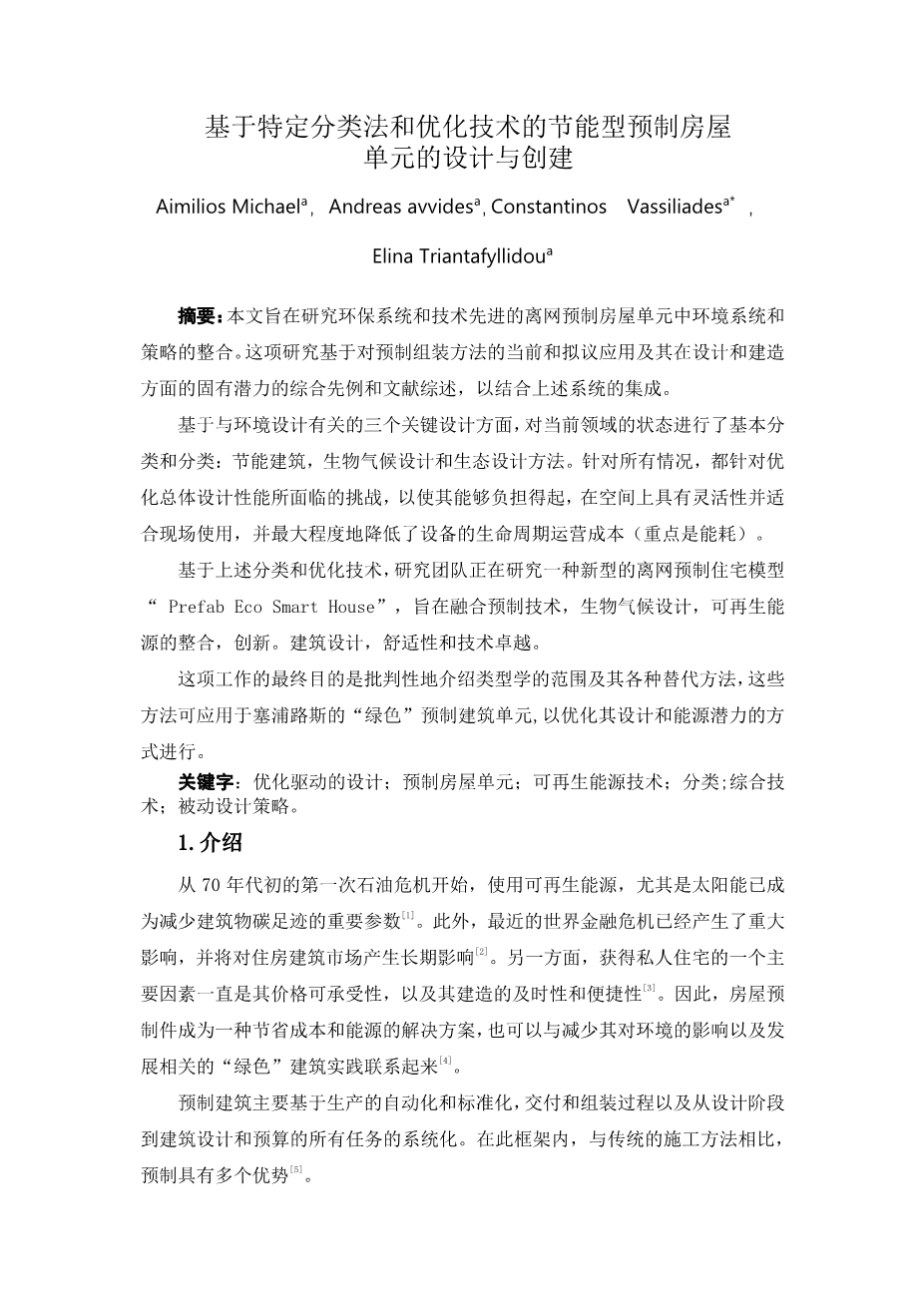Available online at www.sciencedirect.com
ScienceDirect
Procedia Manufacturing 44 (2020) 261–268
1st nternational Conference on ptimiation-Driven Architectural Design ( PTA C 201)
Design and Creation of an Energy Efficient Prefabricated ousing
nit based on pecific Taonomy and ptimiation Techniues
a
a
a
a
Aimilios Michael Andreas avvidesConstantinos Vassiliades Elina Triantafyllidou
aDepartment of Architecture, University of Cyprus
P.O. Box 20537, 1678, Nicosia Cyprus
Abstract
This paper aims to eamine the integration of environmental systems and strategies in environmentally friendly and
technologically advancedoff–grid prefabricated housing units. The study is based on a comprehensive precedent and literature
revie of current and proposed applications of prefabricated assembly methods and their inherent potentialin terms of both
design and constructionto incorporate the integration of the systems mentioned above.
A fundamental classification and taonomy of the current state of the field as performedbased on three ey design aspects
pertaining to the issue of environmental design: Energy efficient structuresbioclimatic design and ecological approach to design.
All cases are addressed in terms of the challenges faced in optimiing the overall design performance so that it leads to an
affordable and spatially fleible and site adaptable construction and also in minimiing the unitslifecycle operational costs ith
an emphasis on energy consumption.
Based on the above taonomy and optimiation techniuesthe research team is oring on a ne off-grid prefabricated
residential modelthe Prefab Eco mart ouseaiming to blend prefabrication technologybioclimatic designintegration of
rene able energy sourcesinnovation in architectural designcomfort and technological ecellence.
The ultimate aim of this effort is to critically present the range of typologies and their various alternatives hich can be applied
on a green prefabricated building unit in Cyprusin ays hich optimie its design and energy potential.
copy; 2020 The Authors. Published by Elsevier B.V.
This is an open access article under the CC BY-NC-ND license (http://creativecommons.org/licenses/by-nc-nd/4.0/)
Peer-review under responsibility of the scientific committee of the 1st International Conference on Optimization-Driven
Architectural Design
Corresponding author. Tel.: 357-228260fa: 357-2285056.
E-mail address: vassiliades.constantinos ucy.ac.cy
2351-9789 copy; 2020 The Authors. Published by Elsevier B.V.
This is an open access article under the CC BY-NC-ND license (http://creativecommons.org/licenses/by-nc-nd/4.0/)
Peer-review under responsibility of the scientific committee of the 1st International Conference on Optimization-Driven Architectural Design
10.1016/j.promfg.2020.02.230
262
Aimilios Michael et al. / Procedia Manufacturing 44 (2020) 261–268
Keywords: optimiation-driven designprefabricated housing unitsrene able energy technologiestaonomyintegrated technologiespassive
design strategies.
1. Introduction
The use of rene able sources and especially solar energy has become an important parameter in reducing a
buildings carbon footprintmore or less beginning ith the first oil crisis in the early seventies 1 . Additionallythe
recent orld financial crisis has had a maor impact and ill have a long-lasting effect on the housing construction
maret 2 . n the other handfor a main factor in the acuisition of a personal residence has al ays been its
affordabilityalongside speed and ease of its construction for a timely completion 3 . Thushousing prefabrication
emerged as a cost-and-energy-saving solution hich can also be lined to the reduction of its environmental impact
as ell as to the development of related green construction practices 4 .
Prefabricated construction is based mainly on the automation and standardiation of productionon the delivery
and assembly processes and the systematiation of all tassfrom the stage of designto the design and budgeting of
construction. ithin this frame orprefabrication has several advantages compared to conventional construction
methods 5 .
At the same timeaccording to the estimation of orld Ban and the nternational Energy Agency (EA)the
anticipated energy demands of developing countries ill need to be doubled over the net 40 years 6 . This fact
combined ith the proection that the 1.3 billion people in developing countries ho live far from cities are
prevented from utiliing grid electricity 7leads to the need of grid installation for electrification of these areas.
o ever this approach is considered astefulsince a large investment is needed and the energy reuirements of
these areas are very lo 8 . Thusdeforestation is becoming a maor environmental issue since 80 of the
people in developing countries ho live in remote areas have to use ood to meet their energy needs 10 .
Conseuentlythis eacerbates the eisting environmental problem hich is caused by the fact that conventional and
finite fossil energy sources are the primary source of energy orld ide 1 0. Therefore the increased use of
rene able energy sources and the need for prefabricated off-grid housing development becomes imperative.
Additionallyregardless of the inconvenience brought on by this uncertaintyprefabricated off-grid housing has
become popularsince peoples enthusiasm in contributing to the global effort for a more sustainable ay of life and
their attitude to ards adopting rene able energy technologies is increasing in the last fe years 11 .
2. State of the Art - Literature Re
剩余内容已隐藏,支付完成后下载完整资料

英语译文共 11 页,剩余内容已隐藏,支付完成后下载完整资料
资料编号:[258962],资料为PDF文档或Word文档,PDF文档可免费转换为Word
以上是毕业论文外文翻译,课题毕业论文、任务书、文献综述、开题报告、程序设计、图纸设计等资料可联系客服协助查找。


